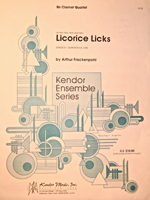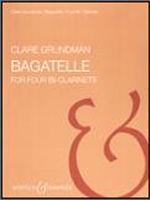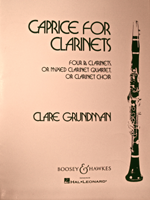Caboodles of Clarinets, Quartets, Vol. 1

These quartets for four B♭ clarinets are appropriate for advanced clarinetists and also work well for casual classical gigs, sight-reading and adult amateurs. All of the selections are original works for clarinet quartet and have become standard repertoire for the ensemble. Complete publishing information can be found below.
Tracks for each piece below are available separately as high-quality mp3 files.
Or, download the entire set (single zip file): Clarinet-Quartets-Vol.-1

Frackenpohl, Arthur; Licorice Licks; Kendor Music, 15125
Arthur Frackenpohl (b. 1934) is one of the only living composers on this website. I heard an interview from 2004 with Professor Frackenpohl on the NPR affiliate, NCPR in Potsdam, New York, where retired Professor Emeritus (Crane School of Music, SUNY Potsdam) Frackenpohl lives. He’s very funny – “I started on the player piano, which was pretty easy… my father was a chopstick guy, not in C, he did the G-flat version…”. The interview featured old friends and students calling in. One caller talked about his and Art’s time on 52nd street in New York, hearing “the old gal that drank scotch and milk” (Billie Holiday), Art Tatum and Errol Garner. Licorice Licks is dedicated to Tom, Dick, Nick and Harry. I asked Dr. Frackenpohl about this work and even though it’s been 30 years since he wrote it, he could tell me all about it in great detail. The quartet was written after visiting his friend Harry Phillips, retired clarinet professor from SUNY Potsdam, in Florida. Harry and his friends (presumably Tom, Dick and Nick) had a quartet that performed on the snow bird trailer park circuit and needed some swinging gig music. Art told me how he got the idea in the car on the way home to New York. He asked me, “I guess you figured out it was a rag?” and then proceeded to tell me that originally he was working with four themes, settled on two, used a variation technique, a little interlude before the trio (all this from memory of a piece he wrote 30 years ago). I’m happy to report that Dr. Arthur Frackenpohl is still well, composing for his church choir, piano and organ and living the life of a much beloved composer and teacher.
This rag will require a great deal of work technically for all the players but it is worth it. Although the composer indicated that it be performed as a fast rag, it also works at a slower tempo. I have had groups do it at 100-108 and it if it is clean, it is still effective. I believe that the 126 tempo is just too fast, it is treacherous to expect accuracy above 112. I have recorded this at two different tempos in order to demonstrate that it is effective within a range of speeds, so please refer to either that you find the most useful.
You will undoubtedly spend lots of time on the passages at mm. 17-18 and 50-52. It is with passages like these that individual practice with a metronome is essential before you come together as an ensemble. There are two obvious wrong notes: in the 1st part, m. 53, last note should be a written ‘f#’; in the 4th part, m. 58, first note should be a written ‘b’ natural. One of the more technically challenging spots is that with the triplet 16th notes in mm. 91 and 95. I found that if I put a breath accent on the second downbeat, everything lines up very well. Dr. Frackenpohl tells me that he also did a large clarinet choir version of this one too, so look for that.
01-Frackenpohl, Licorice Licks Medium Tempo, complete version
02-Frackenpohl, Licorice Licks Medium Tempo, minus 1st part
03-Frackenpohl, Licorice Licks Medium Tempo, minus 2nd part
04-Frackenpohl, Licorice Licks Medium Tempo, minus 3rd part
05-Frackenpohl, Licorice Licks Medium Tempo, minus 4th part
06-Frackenpohl, Licorice Licks Fast Tempo, complete version
07-Frackenpohl, Licorice Licks Fast Tempo, minus 1st part
08-Frackenpohl, Licorice Licks Fast Tempo, minus 2nd part
09-Frackenpohl, Licorice Licks Fast Tempo, minus 3rd part
10-Frackenpohl, Licorice Licks Fast Tempo, minus 4th part
Download all ten tracks (single zip file)

Grundman, Clare; Bagatelle for Four Bb Clarinets; Boosey & Hawkes/Hal Leonard, HL48001338
Clare Ewing Grundman (1913-1996) was an Ohio State graduate, Ohio and Kentucky public school music teacher and eventually returned to Ohio State to teach. He served in the U.S. Coast Guard and then had a successful career composing for musical theater, television, film and radio. Much loved for his band compositions, Grundman was the composer that my first music supervisor in McAllen, Texas complemented by saying, “If I ever need a work for a celebratory band performance, I choose Grundman. He can make any band sound like a Hollywood studio orchestra!” High praise from a Texas band director. By the way, Clare Grundman, Arthur Frackenpohl and Paul Koepke were all crossword enthusiasts. Grundman was a co-author of the New York Times Crossword Puzzle Dictionary. The Bagatelle was composed in 1948.
Here are some of the challenges I found with this piece: 1) Accents and dynamics – from 8 after B to C, make sure accents and dynamics are present where indicated in all parts and the notes that follow return to the dynamic marking. This passage also has a crescendo at the end. 2) Transitions – it seems to make musical sense to add a retard on the last three eighth notes before F as a transition to the meno mosso section. I also added an accelerando the two measures before J for a more musical transition to the Presto ending. 3) Large interval legato – in the meno mosso section we have a particular challenge for clarinet playing. Descending slurs on large intervals require some coordination with air flow and fingering. I’ve included a video on descending slurs and connecting large intervals. This may help you learn this technique.
11-Grundman, Bagatelle for Four Bb Clarinets, complete version
12-Grundman, Bagatelle for Four Bb Clarinets, minus 1st part
13-Grundman, Bagatelle for Four Bb Clarinets, minus 2nd part
14-Grundman, Bagatelle for Four Bb Clarinets, minus 3rd part
15-Grundman, Bagatelle for Four Bb Clarinets, minus 4th part
Download all five tracks (single zip file)

Grundman, Clare; Caprice for Clarinets; Boosey & Hawkes/Hal Leonard, HL48001352
Clare Ewing Grundman (1913-1996) was an Ohio State graduate, Ohio and Kentucky public school music teacher and eventually returned to Ohio State to teach. He served in the U.S. Coast Guard and then had a successful career composing for musical theater, television, film and radio. Much loved for his band compositions, Grundman was the composer that my first music supervisor in McAllen, Texas complemented by saying, “If I ever need a work for a celebratory band performance, I choose Grundman. He can make any band sound like a Hollywood studio orchestra!” High praise from a Texas band director. By the way, Clare Grundman, Arthur Frackenpohl and Paul Koepke were all crossword enthusiasts. Grundman was a co-author of the New York Times Crossword Puzzle Dictionary. The Caprice was composed in 1961.
If you have the score, you’ll notice that Clare arranged this for various combinations – four B-flat soprano clarinets, which I have done; two B-flat soprano clarinets, alto clarinet & bass clarinet; or all of the above with lots of doubling parts as in the clarinet choir version. I have often done quartets with three B-flat soprano clarinets and bass clarinet, so there is another option.
Now, on to performance considerations. Experiment with tempo markings and see what you find to be the best for all concerned. None of the parts are terribly difficult, so in the 126-152 range is reasonable. Stylistically, I wanted a running quality for the Allegro, while the Moderato should have a reflective, sighing quality to it, so not too fast. (I chose 144 for the Allegro, 104 for the Moderato.) I have an affinity for perfect 4ths and 5ths, so I find the Moderato section to be such a beautiful melody to my ears. The 1st player should be free to play with the time within the flow of the accompaniment. Certainly this is subtle, but the lazy beginning of the triplets, the stretch over the top note two measures before J, these are moments when you can listen to your heart, rather than the metronome. I did make a few changes: 1) added accents in 3rd/4th/alto/bass parts at A and four after, same at F and four after; 2) two-bar crescendo, two-bar decrescendo phrases at G, four after G, M, and four after M; 3) Since the four-Bb clarinet version is a compromise (no low ‘c’), I changed the last two notes. I just didn’t like the doubled 3rd on the last chord, so I made the voicing a first-inversion tonic chord. I know, horrors, no root in the bass? Well sorry, not too many of us have a Bb clarinet with a low ‘c’ extension. It sounds better to me to have the 3rd part play a ‘g’ on both the penultimate bar and the last bar and if you are in tune, theoretically the low C is ringing as a difference tone. You see which chord voicing sounds better to you. Whether you stick to the score or use my adjustments, you will enjoy this piece, it is so much fun to play and a delight to hear.
16-Grundman, Caprice for Clarinets, complete version
17-Grundman, Caprice for Clarinets, minus 1st part
18-Grundman, Caprice for Clarinets, minus 2nd part
19-Grundman, Caprice for Clarinets, minus 3rd part
20-Grundman, Caprice for Clarinets, minus 4th part
Download all five tracks (single zip file)




